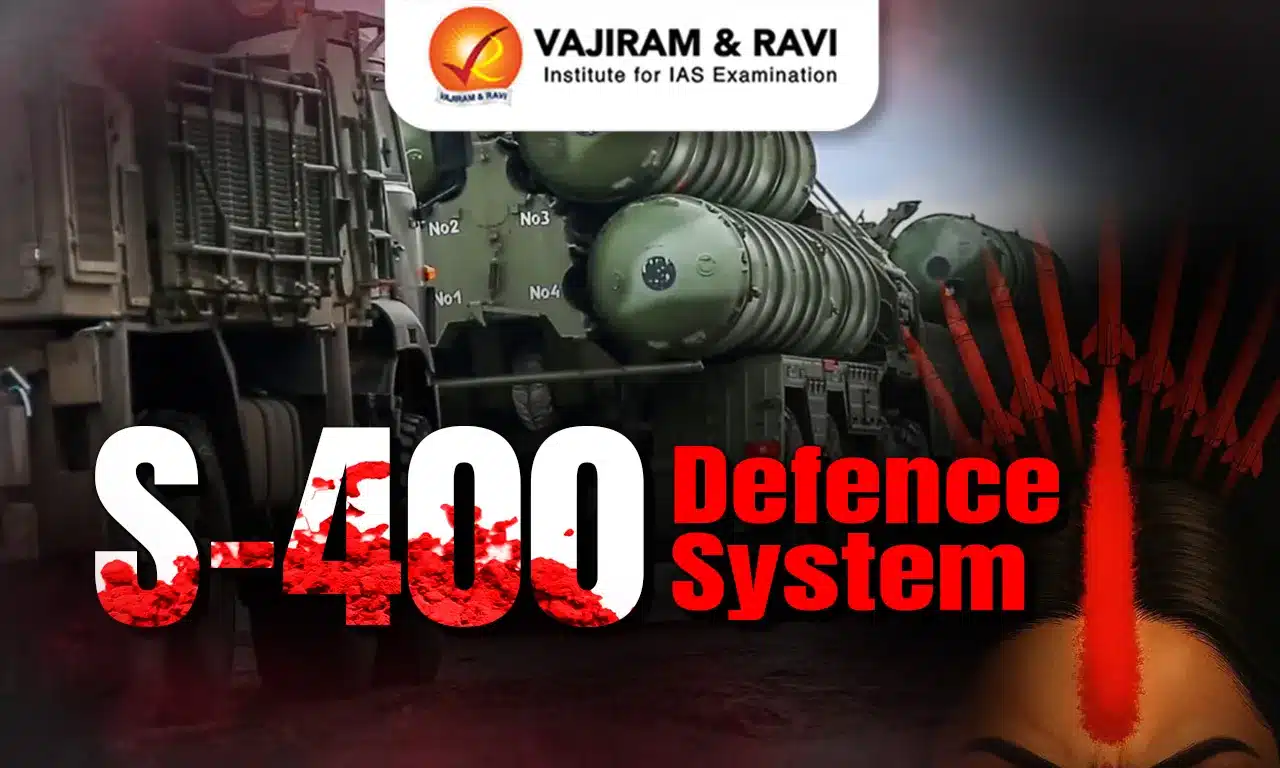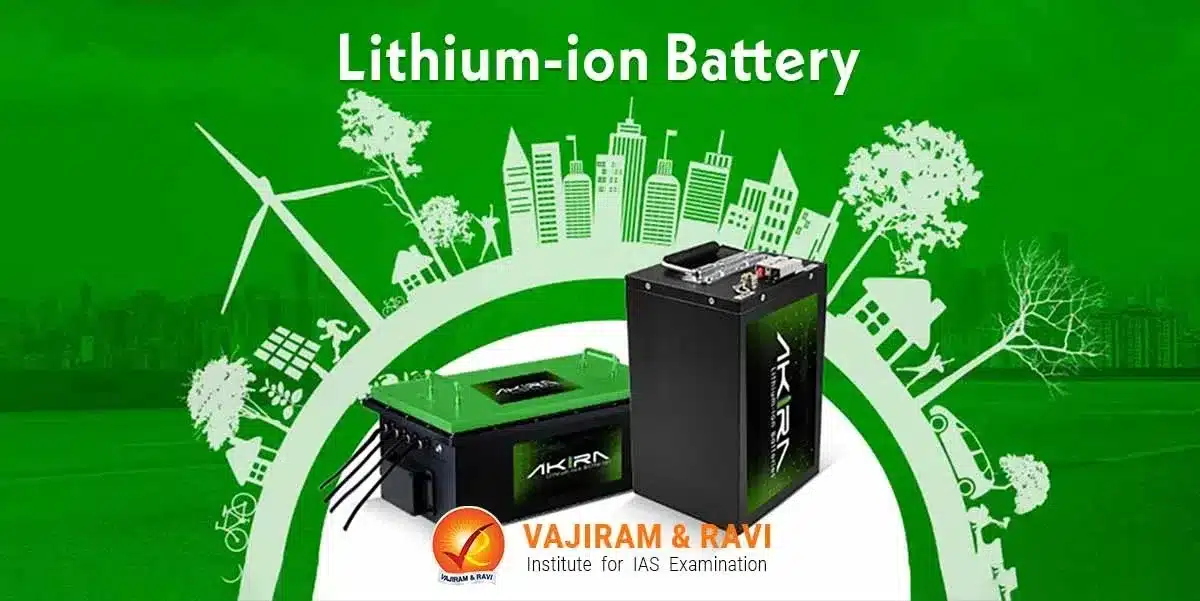S-400 Missile system, also known as “Sudarshana Chakra”, is one of the world’s most advanced long-range surface-to-air missile (SAM) systems, developed by Russia’s Almaz-Antey. India’s acquisition of the Russian-made S-400 Triumf in 2018 has significantly boosted its defensive capabilities through this advanced long-range surface-to-air missile (SAM) system.
During the May 2025 India–Pakistan conflict, India deployed its S-400 Missile defence system to intercept and neutralise multiple Pakistani missile and drone strikes targeting key military installations across northern and western India. The S-400’s advanced capabilities allowed it to thwart a series of coordinated aerial attacks, including those aimed at Jammu, Pathankot, and Amritsar, thereby preventing potential damage to critical infrastructure and military assets.
S-400 Missile System About
S-400 Missile System (SA-21 Growler) is a long-range surface-to-air missile (SAM) system developed by Russia’s Almaz Central Design Bureau in the late 1980s to counter advances in Western air defence systems like the MIM-104 Patriot. It was intended to replace the earlier S-200 and S-300 systems developed in the 1960s-1970s.
S-400 Sudarshan Chakra
India’s S-400 air defence system is named “Sudarshan Chakra” after Lord Vishnu’s mythological weapon, symbolising swift and precise destruction. This designation reflects the system’s capability to detect and neutralise aerial threats rapidly and accurately. The S-400 Sudarshan Chakra enhances India’s defence technology by providing a robust shield against diverse airborne attacks, reinforcing national security.
S 400 Missile Which Country
The S-400 missile system is developed by Russia. It was designed and manufactured by Russia’s Almaz Central Design Bureau as part of the country’s advanced air defense capabilities. India signed the five S-400 missile system deal with Russia in October 2018, boosting India-Russia relations.
S-400 Missile System Features
S-400 missile system stands out for its sophisticated radars, long-range missiles, high mobility, flexibility, adaptability, and networking capabilities. Designed to counter a wide array of aerial threats, the S-400 is a cornerstone of modern air defence. It has significantly enhanced the nation’s air defence capabilities, especially during the recent attack by Pakistan. Some of its features are:
S-400 Missile Speed
S-400 missile system is renowned for its exceptional speed. Its missiles can reach a maximum speed of up to 17,000 km/h (approximately Mach 14), allowing them to intercept fast-moving targets, including high-speed aircraft and ballistic missiles. It can operate at altitudes between 10 meters and 30 kilometres, including intercepting ballistic missiles near the edge of space.
S-400 Missile System Price/Cost
The cost of the S-400 missile system varies based on the configuration and quantity purchased. A single S-400 battery, which includes multiple launchers, radars, and command posts, is estimated to cost around $1.25 billion.
- Maintenance, training, and operational expenses can add to the overall cost over the system’s lifecycle.
- In 2018, India signed a contract worth $5.4 billion (about ₹35,000 crore) for five S-400 units, making it one of the largest defence acquisitions in Indian history.
S-400 Missile Range
S-400 missile system’s missile range varies depending on the specific missile type. The system’s radar can detect targets up to 600 km away.
- 9M96E/9M96E2: These missiles have an engagement range of up to 120 km, ideal for intercepting medium-range threats.
- 48N6E3: With a range of approximately 250 km, this missile is effective against high-speed aircraft and missiles.
- 40N6E: The longest-range missile in the S-400 arsenal, capable of engaging targets at distances up to 400 km, providing a robust defence against advanced threats.
Detection and Tracking
The S-400 missile system boasts impressive features, including a wide area search and track capability, capable of maintaining 300 target tracks while engaging 36 threats. It uses a diverse radar suite, such as the 96L6E, to provide 360-degree surveillance against various targets and can track stealth aircraft using advanced detection methods. Its phased array radars are resilient in electronic warfare environments, with both active and passive guidance ensuring accurate tracking.
Mobility and Rapid Deployment
In terms of mobility, the S-400 is designed for quick deployment, with components mounted on wheeled vehicles for easy transport. The system can be set up in just 5–10 minutes, and the “shoot and scoot” capability allows it to fire missiles and quickly relocate. It offers flexibility with point defence or area defence modes and can engage threats from low to very high altitudes, including ballistic missiles.
Flexibility and Adaptability
The system also adapts to various threats with reprogrammable software, multiple guidance modes (inertial, active, passive, and satellite), and seamless integration with other systems like S-300, Tor, and Pantsir. Its networked sensors and launchers enhance redundancy and resistance to electronic attacks, making the S-400 a formidable defence tool.
S-400 Missile System: Operation Sindoor
The S-400 missile system, popularly known as Sudarshan Chakra, was recently deployed during Operation Sindoor to intercept a Pakistani missile. This came after India conducted a targeted strike on terrorist camps in Pakistan as a response to the Pahalgam terror attack.
- In retaliation, Pakistan launched a coordinated attack using drones and missiles aimed at fifteen Indian cities, including Jammu, Amritsar, Ludhiana, and Bhuj.
- The S-400 system successfully intercepted and neutralised all incoming threats, preventing potential damage to critical military installations and civilian areas.
- This marked the first combat use of the S-400 system by India, demonstrating its capability to track and engage multiple aerial targets simultaneously within a 400 km range.
- The system’s deployment provided a robust shield over India’s airspace, allowing offensive operations, such as Operation Sindoor, to proceed without diversion of resources for homeland defence.
- The successful interception of Pakistan’s aerial threats underscored the S-400’s role as a critical component of India’s multi-layered air defence strategy, enhancing national security and deterrence posture in the region.
Comparison of S-400 Missile System with Other Defence Systems
The S-400 outperforms systems like the MIM-104 Patriot, HQ-9, and THAAD with its longer range, multiple missile types, and superior tracking capabilities, offering more comprehensive coverage and adaptability in diverse defence scenarios.
|
System |
Key Features |
|
MIM-104 Patriot |
– Developed by: USA – It has a 150 km radar range, PAC-3 hit-to-kill missile effective against aircraft, missiles and drones but has a shorter detection range and limited missile options compared to the S-400. |
|
HQ-9 |
– Developed by: China – It has a 200 km radar detection range with active radar-homing missiles and cold launch capability but a shorter detection range and fewer missile types compared to the S-400. |
|
THAAD |
– Developed by: USA – It has a 200 km radar detection range optimised to intercept intermediate-range missiles in the endo-atmospheric region but has a shorter detection range than the S-400 and limited targets, like missiles only. |
|
S-300PMU |
– Developed by: Russia – It has a 200 km radar detection range capable of tracking 300 targets simultaneously with multiple missile options but a shorter detection range than the S-400 as it is an older predecessor system. |
S-400 Missile System Importance
India’s S-400 acquisition from Russia in 2018 is geopolitically significant, giving it leverage in relations with both China and Pakistan.
- Deterrence: The S-400 missile system helps deter regional adversaries such as China and Pakistan. It was recently used by India, which successfully intercepted the incoming missiles from Pakistan. India-Pakistan relations have become sour in recent times.
-
-
- Pakistan: With a 400 km range, the S-400 can cover much of Pakistani airspace, making it possible to enforce “no-fly zones” over border areas, reducing enemy air activity and limiting Pakistani AWACS’ operations.
- China: It can counter China’s J-20 stealth fighters and disrupt support systems like AWACS and aerial refuelling tankers, limiting China’s air campaign capabilities.
-
- Defensive Shield: The S-400 provides a defensive shield over India’s major cities, critical infrastructure and strategic facilities. Delhi, Mumbai, Kolkata and 30 other cities come under the protective umbrella of the system with its 100 km+ engagement radius.
- Sea Denial Against Naval Forces: The S-400’s long-range surveillance can track naval forces, including Chinese aircraft carriers and Pakistan Navy ships, from hundreds of kilometres away. This reduces their ability to operate near India, while shore-based S-400 systems help secure the seas and protect Indian airspace for naval dominance.
- Boosts Air Operations: The S-400 enhances air operations by protecting airbases, forward posts, and strategic infrastructure, allowing India’s offensive air forces to operate without distraction. It reduces the need for homeland defence, enabling forces to focus on targeting adversaries, while also making border patrols safer.
S-400 Missile System Limitations
The S-400 aptly fulfils India’s deterrence requirements from a defensive technology perspective against regional adversaries. Despite boosting India’s military capability, the S-400 has some strategic constraints:
- Defensive-only Asset: It remains a defensive system unable to conduct surface attacks or seize enemy territory.
- China-Pak Nexus: Joint air power cooperation between China and Pakistan, including operations from each other’s soil, can create two-front challenges that increase the stress on Indian air defence.
- Missile Aaps: Upper-tier area defence gaps remain against hypersonic glide vehicles, which the S-400 has yet to demonstrate full capability against. Short-range protection against saturated artillery rocket attacks is also limited.
- Cost Implications: The S-400’s high unit and lifecycle costs constrain funding available for other military modernisation programs. It impacts the fiscal headroom for acquisition.
- Geopolitical Fallout: More S-400 purchases could attract US sanctions. Acquiring interoperable Western systems gets complicated. The S-400 thus also brings geopolitical costs.
S-400 Missile System Way Forward
While transformative in capability, the S-400 also poses several challenges that India must systematically address to fully benefit from the system. Some key issues are:
- Integration with Existing Networks: The IAF has legacy Soviet-origin systems like S-125 Pechora, OSA-AK, and Kvadrat and upgraded variants alongside newer European acquisitions like MRSAM and Spyder.
- Integrating the Russian-made S-400’s datalinks and systems seamlessly into this heterogeneous network with older Indian, Western and Russian platforms will involve technical complexity.
- Training: Operating the S-400 requires overseeing a complex mix of sensors, data links, C4I centres and shooters. Comprehensive training of personnel at the operator and supervisory levels is essential.
- Address Gaps: Notwithstanding its formidable capabilities, the S-400 cannot address all air defence requirements by itself. A multi-tier architecture is necessary to plug weaknesses.
- Short-range MANPADS and SHORADS units to protect S-400 batteries and address low-altitude threats. Systems like MPADS, VL-SRSAM and truck-mounted guns fit this requirement.
- A coordinated network of short, medium and long-range air defence systems is necessary to optimise capabilities and address vulnerabilities across the full spectrum of threats.
- Adapting Strategies Against Emerging Threats: New threats like hypersonic glide vehicles, mini and nano drones, loitering munitions and 5th-generation aircraft using advanced countermeasures are growing air defence challenges. Adapting to these requires doctrinal and tactical innovation.
The S-400 thus significantly strengthens India’s defensive capabilities. But more efforts are needed in integration, training, and ecosystem creation to exploit its full potential. Developing flexible strategies to address some limitations is important alongside offensive capability growth.
S-400 Missile System UPSC PYQs
Q1: How is the S-400 air defence system technically superior to any other system presently available in the world? (UPSC Mains 2021)
Last updated on May, 2025
→ UPSC Notification 2025 was released on 22nd January 2025.
→ UPSC Prelims Result 2025 will be out soon for the CSE held on 25 May 2025.
→ UPSC Prelims Question Paper 2025 and Unofficial Prelims Answer Key 2025 are available now.
→ UPSC Calendar 2026 is released on 15th May, 2025.
→ The UPSC Vacancy 2025 were released 1129, out of which 979 were for UPSC CSE and remaining 150 are for UPSC IFoS.
→ UPSC Mains 2025 will be conducted on 22nd August 2025.
→ UPSC Prelims 2026 will be conducted on 24th May, 2026 & UPSC Mains 2026 will be conducted on 21st August 2026.
→ The UPSC Selection Process is of 3 stages-Prelims, Mains and Interview.
→ UPSC Result 2024 is released with latest UPSC Marksheet 2024. Check Now!
→ UPSC Toppers List 2024 is released now. Shakti Dubey is UPSC AIR 1 2024 Topper.
→ Also check Best IAS Coaching in Delhi
S-400 Missile System FAQs
Q1. How many S-400 systems does India have?+
Q2. How good is the S-400 missile system?+
Q3. How many missiles does the S-400 have?+
Q4. Which is the best air defence system in the world?+
Q5. Is S-400 better than Iron Dome?+



















